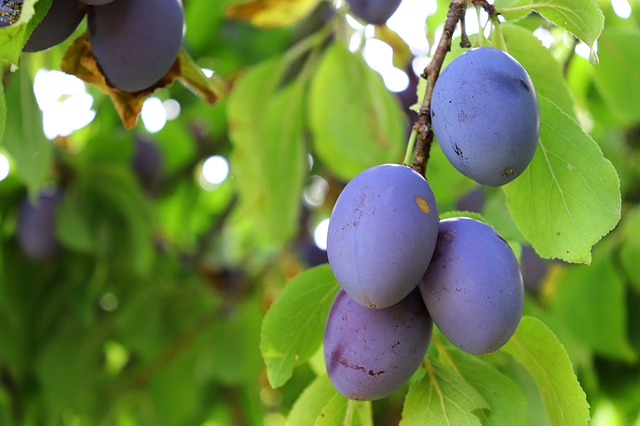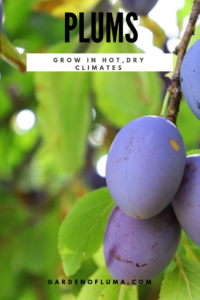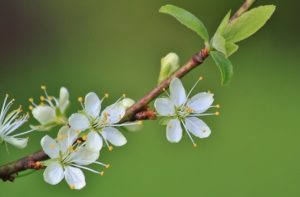Growing Plum Trees in Hot, Dry Climates

I always assumed that Plum trees grew in more temperate climates. I remember climbing into some trees as a kid in Northern Michigan and feasting on juicy plums. When I first purchased a home in Arizona, I discovered plum trees at the local big box store and decided to give one a try. I soon learned a lot of things that I wish I had known about plum trees, prior to purchasing one.
At my previous residence in Phoenix, Arizona, I had two plum trees growing.
One of the first fruit trees that I planted was an Elephant Heart Plum tree.
I was a newbie to growing fruit trees and had no idea what I was doing.
I learned a couple things after planting my Elephant Heart Plum tree.
One was that chill hours are an important thing to consider when planting fruit trees.
An Elephant Heart Plum tree has a lot higher requirement for chill hours than what we average in our area.
It seems that the big box stores will sell anything, even if it isn’t really suited to your climate.
Lesson number two was that some fruit trees require another variety to cross-pollinate.
I had no idea that some fruit tree varieties weren’t able to produce fruit on their own.
Many plum tree varieties require a second variety for cross-pollination, so it’s important to do a little research beforehand.
After a few years, I ended up planting a second plum variety called Santa Rosa.
I was able to get a couple plums on my Elephant Heart Plum tree in its 5th year.
My Santa Rosa was 3 years old when we moved and it hadn’t yet fruited.
Sprite-Delight Cherry Plum
I’m currently growing a Sprite-Delight Cherry Plum Tree.
When I purchased this tree, I thought it was a cross between a plum and cherry.
Since cherries just don’t want to work in our extreme heat, I’ve been looking for something similar to a cherry.
It’s actually a cross between a Japanese plum and cherry-plum, which is closer to a traditional plum.
Even though it doesn’t sound like it will be as cherry like as I hoped, I’m still excited about this tree.
I planted the tree as a bare root tree, meaning it wasn’t in a pot of soil when I purchased it.
For trees that go dormant, like stone fruit trees, nurseries can uproot the trees and ship them soil-less.
It makes it a lot easier to handle the trees during shipping and planting.
This tree has two varieties grafted on to it.
One side of the tree is the Sprite variety and the other side is the Delight.
The Sprite and Delight Cherry Plums flower around the same time and cross-pollinate each other.
Fruiting

I’ve yet to get fruit off my Sprite-Delight Cherry Plum in its first 2 years.
I’ve seen photos of some other gardeners in my area that have had success with getting this tree to fruit in our climate.
It seems to produce fairly well and I’ve heard good things about the fruit.
The Sprite variety is reportedly sweeter, while the Delight is a bit tangier.
Another thing to consider with Plums in hot climates is that they tend to ripen later in the year.
Here in the desert, we want fruit that will ripen as early as possible, so it doesn’t cook through the heat.
It’s a good idea to look for varieties that fruit earlier in the year.
Methley, Santa Rosa, Beauty, and Burgundy tend to be a few good varieties for hot, dry climates.
Gardening Skill Level
I would say that growing Plum trees in a hot, dry climate takes a beginner to moderate skill level.
Plums do take some extra care with pruning to get optimal fruit crops.
Fruiting occurs on spurs that come off of branches.
Some of the potential risks for diseases and the challenges with finding an optimal rootstock can make growing Plum trees a little bit more of a challenge.
Overall, they can handle a hot, dry climate fairly well, and winters are a breeze.

Suitable for Container Growing
I’ve never attempted to grow a Plum tree in a container and wouldn’t recommend it.
Unless you get a dwarf variety that is more geared towards small spaces, I’d plan on planting your plum tree in the ground.
I think stone fruits can be a little more susceptible to fungal and root diseases, which concerns me with trying to grow them in a container.
With proper care, it could be doable, so I’m never opposed to giving something a try, but your best bet for success is going to be in the ground.
Planting Tips
When planting my Plum tree, I wanted it to be in a spot that would get ample sun in the summer months, but also be one of the coldest spots in my yard in the winter time.
The Sprite-Delight Plum tree requires around 400 chill hours which is somewhat marginal in our area.
Also, since my tree is on the Citation rootstock, I planted it in a spot that has a bit more water retention.
The soil still drains fairly well, but definitely is more clay than some other areas of my yard.
Watering
The Sprite-Delight Cherry Plum tree that I’m growing is on Citation rootstock, which isn’t the best for dry climates.
Citation rootstocks are more tolerant of wet soil conditions, so I tend to water my cherry plum tree more frequently than a typical stone fruit tree.
I treat it similar to more of a tropical tree when it comes to watering.
Feeding

I feed my Sprite-Delight Cherry Plum tree consistently with fish emulsion and liquid seaweed.
Here are some of the fertilizer products that I use and recommend.
I also occasionally use some granular feeds, as well as topping with compost a few times a year.
Sun Exposure
Plum trees do fairly well in full sun exposure, even in a desert climate.
If planted in complete full sun, the leaves will tend to get some scorching by the end of the summer.
Planting them in an area where they can get a bit of relief from the late afternoon sun can help, but isn’t necessary.
Potential Problems
Plum trees are susceptible to diseases like crown rot and canker.
Canker has been a problem in our area, which can potentially come on fast, and kill a tree.
If you notice areas of amber color sap it can be a cause for concern.
Borers are also another major potential problem that can be fatal to the tree.
Borers eat away at the trunk and branches of trees causing dead spots.
Sometimes copper sprays are needed for things like shot hole on the leaves.
Otherwise, I don’t have too many issues with pests.
Please comment below on anything you enjoyed from this post and your experiences with growing Plum Trees in Hot, Dry Climates.
